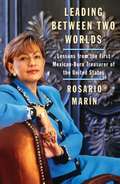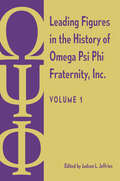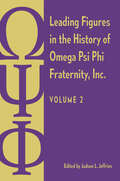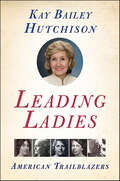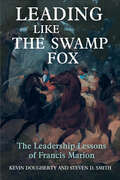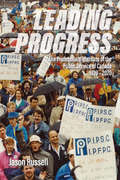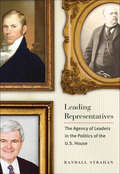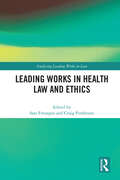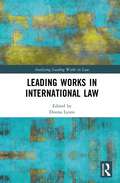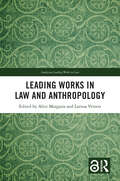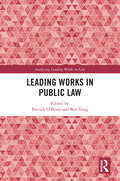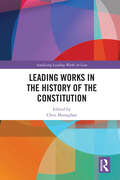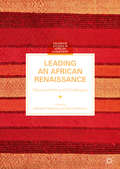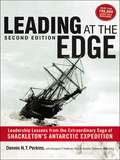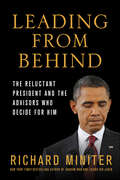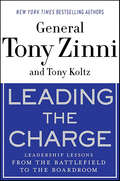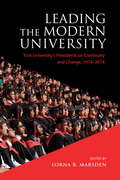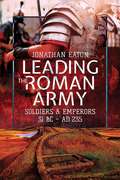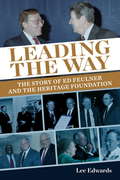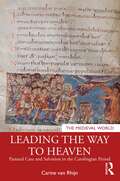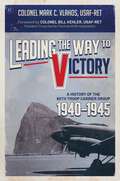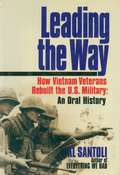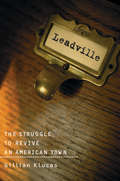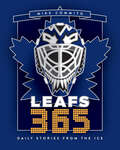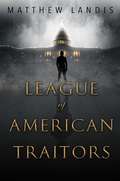- Table View
- List View
Leading Between Two Worlds: Lessons from the First Mexican-born Treasurer of the United States
by Rosario Marin"The American Dream is the fundamental story of this country, and my life is a grateful reflection of its reality." When Rosario was fourteen years old she moved from Mexico to California with no grasp of the English language and few resources. She has since become a trailblazer in every sense: from becoming the first in her family to graduate from college to having her signature appear on the U.S. dollar bill as the treasurer of the United States, and the first Latina in California to run for the U.S. Senate. Leading Between Two Worlds is the story of this incredible journey. Rosario exposes her most personal secrets and impressive achievements as she divulges what she has sacrificed and what she has gained in politics. She takes us through a deeply felt betrayal, her struggle through depression, the creation of her family, her devotion to advocating for the rights of people with disabilities, and her joyous return to Mexico. Rosario's story is the story of every immigrant who -- in the face of unbelievable adversity -- seeks to make it in the United States. Her journey is one of tragedy and triumph, one from which readers will draw inspiration.
Leading Figures in the History of Omega Psi Phi Fraternity, Inc.: Volume 1
by Judson L. JeffriesHighlighting 21 members of this illustrious historically Black fraternity Omega Psi Phi Fraternity, Inc., was founded in 1911 at Howard University to cultivate and nurture a generation of leaders who would work toward racial uplift and influence American society. In an unprecedented two volumes, Judson Jeffries brings together original works on 21 of the fraternity’s accomplished and influential members. Written by a diverse group of scholars, these profiles highlight the national importance of these figures in their chosen fields of endeavor, as well as the enormous impact of this great fraternity. In volume 1, Jeffries presents a prologue and introduction that outline the story of the fraternity’s founding in the context of the racial, social, political, and educational history of the period. This volume spotlights scientists Ernest E. Just and Percy Lavon Julian; civil rights lawyers Fred Gray, Oliver Hill, Spottswood Robinson, and Oscar W. Adams Jr.; sports legends Robert Lee Elder and Clarence Gaines; and musicians Count Basie, Max Roach, and Roland Hayes.Including both widely recognized and little-known individuals and featuring people who were on the front lines of the struggle for racial equality and those whose work took place behind the scenes, these volumes show the contributions of Black leaders in the areas of science, civil rights, athletics, the arts, the military, politics, education, and more. Leading Figures in the History of Omega Psi Phi Fraternity, Inc. is a testament to the significance of Black Greek-letter organizations, whose members have made history through lives of struggle, accomplishment, triumph, and uplift. Contributors: Arthur Smith | Kevin C. McDonald | Marvin P. Dawkins | Theodore Walker, Jr. | Marvin Chiles | Waweise Schmidt | Bertis D. English | Judson L. Jeffries | Jomills Henry Braddock II | Matthew Buttermann | Christopher A. Brooks | Derryn Moten
Leading Figures in the History of Omega Psi Phi Fraternity, Inc.: Volume 2
by Judson L. JeffriesHighlighting 21 members of this illustrious historically Black fraternity Omega Psi Phi Fraternity, Inc., was founded in 1911 at Howard University to cultivate and nurture a generation of leaders who would work toward racial uplift and influence American society. In an unprecedented two volumes, Judson Jeffries brings together original works on 21 of the fraternity’s accomplished and influential members. Written by a diverse group of scholars, these profiles highlight the national importance of these figures in their chosen fields of endeavor as well as the enormous impact of this great fraternity. Volume 2 discusses Brigadier General Charles Young; artist and activist Charlotte "Lottie" Wilson, affectionately considered the fraternity's lone female member; modern civil rights activists T.R.M. Howard, Bayard Rustin, Lawrence Guyot, Jesse L. Jackson, and Emory O. Jackson; and scholars Lewis V. Baldwin, Asa Grant Hilliard III, and Benjamin E. Mays. Jeffries concludes by celebrating the recent rise in scholarship that draws attention to the fraternities and sororities that have connected other Black trailblazers such as these. Including both widely recognized and little-known individuals and featuring people who were on the front lines of the struggle for racial equality and those whose work took place behind the scenes, these volumes show the contributions of Black leaders in the areas of science, civil rights, athletics, the arts, the military, politics, education, and more. Leading Figures in the History of Omega Psi Phi Fraternity, Inc. is a testament to the significance of Black Greek-letter organizations, whose members have made history through lives of struggle, accomplishment, triumph, and uplift. Contributors: Judson L. Jeffries | Qiana M. Cutts | Francis V. Gourrier, Jr. | Dereck J. Rovaris | Kyle Brooks | Brian G. Shellum | Kimberly Mangun | Cynthia Hawkins | William J. Southerland | Raymond Sommerville | Jeaninne D. Wallace
Leading Ladies: American Trailblazers
by Kay Bailey HutchisonUnited States senator Kay Bailey Hutchison examines the lives of sixty-three pioneers in military service, journalism, public health, social reform, science, and politics—all American women.Following in the footsteps of her national bestseller, American Heroines, Senator Kay Bailey Hutchison celebrates female accomplishment in all walks of life. From the Nobel Prize to the halls of Congress, the trailblazers profiled in these skillfully drawn biographical portraits have battled tremendous odds to achieve success—if not always recognition—in their respective fields. Whether committed to a chosen cause or thrust into a public role by personal circumstance, these courageous women have all woven the thin threads of opportunity into sweeping tapestries of achievement.Mixing historical portraits with modern success stories, Senator Hutchison shows how American women from all periods of history have contributed to the strength and progress of our nation—and no history of the nation can be written without them.
Leading Like the Swamp Fox: The Leadership Lessons of Francis Marion
by Steven D. Smith Kevin DoughertyA riveting and applicable study of how Francis Marion delivered the leadership and strategy to defeat the British in the South Carolina lowcountry campaigns.Francis Marion is certainly the stuff of which legends are made. His nickname “The Swamp Fox,” bestowed upon him by one of his fiercest enemies, captures his wily approach to battle. The embellishment of his exploits in Parson Weems’ early biography make separation of fact from fiction difficult, but certainly represents the awe, loyalty, and attraction he produced in those around him. His legacy is enshrined in the fact that more places in the United States have been named after him than any other soldier of the American Revolution, with the sole exception of George Washington. Even today’s U.S. Army Rangers include Marion as one of their formative heroes. Surely much about leadership can be learned from such an intriguing personality. Leading like the Swamp Fox: The Leadership Lessons of Francis Marion unlocks those lessons. Divided into three parts, the book first presents the historical background and context necessary to appreciate Marion’s situation. The main body of the book then examines Marion’s leadership across eight categories, with a number of vignettes demonstrating Marion’s competency. The summary then captures some conclusions about how leadership impacted the American Revolution in the South Carolina Lowcountry. An appendix provides some information about how the reader might explore those physical reminders of Marion and his exploits that exist today. Readers interested in history or leadership, or both, will all find something for them in Leading like the Swamp Fox.
Leading Progress: The Professional Institute of the Public Service Canada 1920–2020
by Jason RussellOn February 6, 1920, a small group of public service employees met for the first time to form a professional association. A century later, the Professional Institute of the Public Service Canada (PIPSC) is a bargaining agent representing close to 60,000 public sector workers, whose collective efforts for the public good have touched the lives of every Canadian. Published on the centennial of PIPSC’s founding, Leading Progress is the definitive account of its evolution from then to now—and a rare glimpse into an under-studied corner of North American labour history. Researcher Dr. Jason Russell draws on a rich collection of sources, including archival material and oral history interviews with dozens of current and past PIPSC members. The story that unfolds is a complex one, filled with success and struggle, told with clarity and even-handedness. After decades of demographic and generational shifts, economic booms and busts, and political sea change, PIPSC looks toward its next hundred years with its mission as strong as ever: to advocate for social and economic justice that benefits all Canadians.
Leading Representatives: The Agency of Leaders in the Politics of the U.S. House (Interpreting American Politics)
by Randall StrahanAn in-depth examination of the role U.S. House leadership plays in shaping America’s national policy and political system.Many studies of Congress hold that congressional leaders are “agents” of their followers, ascertaining what legislators agree on and acting to advance those issues rather than stepping to the forefront to shape national policy or the institution they lead. Randall Strahan argues that this approach to understanding leadership is incomplete. Here he demonstrates why and explores the independent contributions leaders make in congressional politics.Leading Representatives is a study that draws on both historical and contemporary cases to show how U.S. House leaders have advanced changes inside Congress and in national policy. Exploring the tactics, tenure, and efficacy of the leadership of three of the most colorful and prominent Speakers of the House—Henry Clay, Thomas Reed, and Newt Gingrich—Strahan finds that these men, though separated in time and of differing thought and actions, were all leaders willing to take political risks to advance goals they cared about deeply. As a result, each acted independently of his followers to alter the political landscape. Strahan makes use of a wide range of resources, including the former representatives’ papers and correspondence and interviews with Gingrich and his staffers, to demonstrate how these important leaders influenced policy and politics and where they ran aground.In expounding lessons Strahan has gleaned over two decades of studying U.S. legislative politics, Leading Representatives offers a new theoretical framework—the conditional agency perspective—that effectively links contextual perspectives as applied to congressional leadership with those emphasizing characteristics of individual leaders.
Leading Works in Health Law and Ethics (Analysing Leading Works in Law)
by Sara Fovargue Craig PurshouseHealth and healthcare are vitally important to all of us, and academic interest in the law regulating health has, over the last 50 years, become an important field of academic study. An analysis of the development of, changes in, and scope of health law and ethics to date, is both timely and of interest to students and scholars alike, along with an exploration of its likely future development. This work brings together contributions from leading and emerging scholars in the field. Each contributor has been invited to select and analyse a ‘leading work’, which has for them shed light on the way that health law and ethics has developed. The chapters are both autobiographical, reflecting upon the works that have proved significant to contributors, and also critical analyses of the current state of the field. This collection also includes a specially written Introduction and Conclusion, which critically reflect upon the development of health law and ethics and its likely future developments in the light of the reflections by contributors on their chosen leading works. The book will be of interest to students, teachers, and researchers in health law and ethics, as it provides critical discussions and assessments of some of the leading scholarship in the field.
Leading Works in International Law (Analysing Leading Works in Law)
by Donna LyonsThis volume provides an innovative and engaging way of assessing the development of international law scholarship and practice to date and its potential future development by focusing upon the ‘leading works’ of the discipline. International law has established itself as an important area of academic study and legal practice. Given its academic, legal and everyday significance and its prolific role within law school teaching and research, it is important to question and analyse the development of international law, exploring the complex and shifting interplay between law, policy, theory and culture and the role of international and national actors within a diverse and dynamic community of nations. This collection presents contributions from leading scholars of public international law across the globe and the works chosen by the editor represent a diverse range of subjects within the broader discipline. Each chapter analyses the importance and legacy of a specific work, with a view to reflecting upon how that publication has contributed to shaping the broader literature in the field of international law and how it may continue to have an influence on both scholarship and practice in the future. Taken as a whole, the chapters included in this collection provide an original exploration of a variety of important themes about how the discipline has evolved over time. The Prologue and Epilogue critically assess the development of international law in light of the reflections by contributors. The book will be a valuable resource for lawyers, international law practitioners, students, and academics alike.
Leading Works in Law and Anthropology (Analysing Leading Works in Law)
by Edited by Alice Margaria and Larissa VettersThe academic disciplines of law and sociocultural anthropology have a long but at times contentious history of drawing on each other in order to study and understand law and human experience in its diverse manifestations. This volume provides an innovative and engaging format by giving established and emerging scholars from diverse jurisdictions the opportunity to discuss and reflect upon what they consider to be a ‘leading work’. The collection offers a unique, multi-perspectival reconsideration of the intellectual history of the field whilst also addressing issues that are at the core of interdisciplinary legal research. Contributions shed light on the changing nature of cross-disciplinary research and collaboration, trace how disciplinary understandings of normativity have cross-fertilised each other, and reflect on choices taken within research on law and anthropology along a continuum of theoretical reflection, critique, engagement, and practical application. The book elaborates on the nature and the boundaries of law and anthropology research, as well as on its likely future development in light of the insights shared by contributors on their chosen leading works. The book will make fascinating reading for researchers and academics in both law and anthropology.Chapter 1 of this book is freely available as a downloadable Open Access PDF at http://www.taylorfrancis.com under a Creative Commons Attribution-Non Commercial-No Derivatives (CC-BY-NC-ND) 4.0 license.
Leading Works in Public Law (Analysing Leading Works in Law)
by Patrick O’Brien and Ben YongThis book brings together a group of leading scholars working in public law and constitutional theory. It examines accepted leading works of public law while also exploring those that deserve greater attention. Over 13 chapters, a group of leading public law experts each examine one leading work from the UK public law canon. Each chapter critically reflects on the context of a work in public law, taking into account not just the work and its context but also how it shapes and contributes to the broader discipline. The final chapter offers an international overview of the chapters themselves, reflecting critically on the scholarly canon of UK public law from the perspective of American constitutional scholarship. The book will be of interest to scholars and students of constitutional law.
Leading Works in the History of the Constitution (Analysing Leading Works in Law)
by Chris MonaghanThis collection brings together academic analysis of leading contemporary accounts of the British Constitution with key constitutional documents and sources while also offering analysis of the leading histories of the Constitution.The works in question represent examples of the constitutionally most significant legislation, judicial decisions and commentaries by scholars and key actors. Its scope is the 700 years of English and then British history from the Magna Carta to Britain as an imperial power grappling with the question of how to govern India.The contributors, presenting a balance of established academics and early career researchers, present an original and succinct account of the significance of each leading work. They draw upon the context in which it was written, contemporary literature and more modern academic analysis of the work and its author(s).Presenting a complement to standard texts on the history of the Constitution, the book will be of interest to researchers and academics working in the areas of Constitutional Law and Politics, Public Law and Legal History.
Leading an African Renaissance
by Kathleen Patterson Bruce WinstonThis book looks at the challenges and possibilities facing leadership in Africa today by providing a rich history of the continent, the complexities the continent has experienced, and the great hope and encouragement that remains. It explores what African leadership is and the possible effects it has on leaders, followers, and organizations across the continent. While some maintain that leadership of and within Africa presents too many challenges, this book argues that Africa is ripe with potential and on the verge of an African Renaissance. This book looks beyond socioeconomic factors to explore different perspectives of leadership such as holistic, transformational, and servant leadership, as well as values and ethics. Taking a philosophical and pragmatic approach, this edited collection provides insight from African-born leadership scholars to deliver a first-hand account of the challenges the continent faces. Their unique experiences and immersion in the African world pave the way for a revival of leadership through a lens of history, tradition, economics, societal, and leadership perspectives.
Leading at The Edge: Leadership Lessons from the Extraordinary Saga of Shackleton's Antarctic Expedition
by Dennis Perkins Margaret Holtman Jillian MurphyDrawing on the amazing story of Shackleton and his polar exploration team&’s survival against all odds, author Dennis N. T. Perkins demonstrates the importance of a strong leader in times of adversity, uncertainty, and change.Part adventure tale and part leadership guide, Leading at the Edge uncovers what the legendary Antarctic adventure of Sir Ernest Shackleton, his ship Endurance, and his team of twenty-seven polar explorers can teach us about bringing order to chaos through true leadership.Among other skills, you&’ll learn how to:instill optimism while staying grounded in reality,step up to risks worth taking,consistently reinforce your team message,set a personal example,find things to celebrate,laugh small things off,and--even in the face of extreme temperatures, hazardous ice, scarce food, and complete isolation--never give up.This second edition of Leading at the Edge features additional lessons, new case studies of the strategies in action, tools to uncover and resolve conflicts, and expanded resources.An updated epilogue compares the leadership styles of the famous polar explorers Shackleton, Amundsen, and Scott, which transcend the one-hundred-plus years since their historic race to the South Pole to help today&’s leaders learn valuable lessons about the meaning of true success.
Leading from Behind: The Reluctant President and the Advisors Who Decide for Him
by Richard MiniterBarack Obama has never been fully vetted—until now. In the New York Times bestselling Leading from Behind, investigative journalist Richard Miniter presents the first book to explore President Obama's abilities as a leader, by unearthing new details of his biggest successes and failures. Based on exclusive interviews and never-before-published material, Leading from Behind investigates the secret world of the West Wing and the combative personalities that shape historic events. Contrary to the White House narrative, which aims to define Obama as a visionary leader, Leading from Behind reveals a president who is indecisive, moody, and often paralyzed by competing political considerations. Many victories—as well as several significant failures—during the Obama presidency are revealed to be the work of strong women, who led when the president did not: then-Speaker Nancy Pelosi; Secretary of State Hillary Clinton; and Valerie Jarrett, his closest adviser and an Obama family confidante, whose unusual degree of influence has been a source of conflict with veteran political insiders.In Leading from Behind, you will learn:· Why Obama's relationship with Israel was poisoned years before he met Israel's prime minister Benjamin Netanyahu· The real reason for Valerie Jarrett's strong hold over both Barack and Michelle Obama· ObamaCare wasn't Obama's idea. It was House Speaker Nancy Pelosi's. And the real reason he danced to her tune.· Obama delayed and canceled the mission to kill Osama bin Laden three times and then committed an intelligence blunder that allowed dozens of high-level members of al Qaeda to escape.· Why Obama destroyed a secret budget deal with House Speaker John Boehner that would have reformed entitlements, slashed spending, and reduced the national debt—without raising taxes· Why Obama is determined to save Attorney General Eric Holder, even though he has mislead and stonewalled Congress about "Operation: Fast and Furious"· Why Obama decided to defy the Tea Party and ditch his plans to end earmarksIn Leading from Behind, Richard Miniter's provocative research offers a dramatic, thoroughly sourced account of President Obama's White House during a time of intense domestic controversy and international turmoil.
Leading the Charge: Leadership Lessons from the Battlefield to the Boardroom
by Tony Koltz Tony Zinni"What's happened to our leaders and to our leadership?"Based on General Zinni's leadership experiences from the battlefield to the boardroom, Leading the Charge shows a new way through the significant leadership challenges of the 21st century.The times are changing at an ever-increasing velocity. Old systems, organizations, and ways of operating no longer work in our dynamic, complex and increasingly unstable new environment. Out of this chaos and confusion, a new and different leader must emerge. Old systems and methods will no longer work. Leading the Charge is a visionary leadership book that examines the trends that have reshaped our world and the ways in which visionary leaders and organizations can effectively respond. Tomorrow's successful leaders--in all fields, including the military, academia, politics, and business--must know how to create, operate, and thrive in very fluid, flattened, and integrated structures that are remarkably different from the traditional organizations we are used to seeing. They will have to manage rapidly changing technology and flows of information, and create faster and more far-reaching spans of control. Leading the Charge shows the way, and is an incisive and compelling guide to the new world of leadership, one that will prove indispensable for years to come.Organized around "Leading a New World," a revolutionary leadership course General Zinni developed and taught at the Terry Sanford Institute of Public Policy at Duke University, Leading the Charge makes a convincing case that leaders must . . . - change with the times to be relevant.- be ready for crisis mode at any given time.- have a moral compass and the ability to steer the company in the right direction.- be forward thinking, not reactive, to provide innovation and creativity.- develop great leaders.
Leading the Modern University: York University’s Presidents on Continuity and Change, 1974-2014
by Lorna R. MarsdenFounded in 1959, York University is now the second largest university in Ontario and third largest university in Canada. However, starting in 1970s the success of the university was far from guaranteed.Leading the Modern University documents the challenges and solutions that five successive university presidents (H. Ian Macdonald, Harry Arthurs, Susan Mann, Lorna Marsden, and Mamdouh Shoukri) encountered from the very early 1970s up to 2014. This book is the rare occurrence where a series of university presidents describe and analyze the challenges they faced regarding financing, morale crises, and succession. With each president contributing a chapter, covering her or his own years in office, Leading the Modern University reveals that large public institutions have internal dynamics and external forces that supersede any individual leader's years in office. This is a case study for those interested in organizational change as seen by the leadership of a major public institution during a dynamic period in higher education.
Leading the Roman Army: Soldiers & Emperors, 31 BC–235 AD
by Jonathan EatonA historian and archeological scholar examines the complex relationship between Roman emperors and their armies.For the emperors of Ancient Rome, effective political management of the army was vital to the overall stability of the empire. In Leading the Roman Army, historian Jonathan Mark Eaton examines how emperors endeavored to control the military from the battle of Actium in 31 BC, to the demise of the Severan dynasty in AD 235.This study draws on the latest evidence from archaeological, epigraphic, literary and numismatic sources on the relationship between the emperor and his soldiers. It demonstrates that the emperor was not only the army’s commander-in-chief, but also their patron and benefactor, even after their discharge from military service.With forces dispersed along the frontiers of the empire, the emperor needed a strong military hierarchy to impose discipline. He also needed to ensure the loyalty of his officers by building mutually beneficial relationships with them. To this end, the imperial army became a complex network of loyalty ties which protected the emperor from military subversion.
Leading the Way
by Lee EdwardsThe remarkable history of The Heritage Foundation, its influential founder, and the conservative movement in America.Leading the Way tells the story of how Ed Feulner has transformed policymaking in Washington and has led The Heritage Foundation into becoming the most influential conservative think tank in the nation. Under Ed Feulner and for 36 years, Heritage has shaped politics with conservative solutions for such critical issues as entitlements, national security, missile defense, health care, welfare reform, immigration, free trade, energy, and the role of the family and religion in society. Today, with over hundreds of thousands of members and an annual budget of more than $80 million, Heritage is a permanent Washington institution and the leading exponent of conservative ideas in America and around the world. The man who made it happen is Ed Feulner, intellectual entrepreneur, hands-on manager, legendary fundraiser, presidential adviser, bestselling author, and world traveler--a man who never stops and was described by The Economist as "one of the most influential conservatives in America."
Leading the Way to Heaven: Pastoral Care and Salvation in the Carolingian Period (The Medieval World)
by Carine van RhijnStarting from manuscripts compiled for local priests in the Carolingian period, this book investigates the way in which pastoral care took shape at the local levels of society. They show what illiterate lay people learned about their religion, but also what priests themselves knew. The Carolingian royal dynasty, which ruled over much of Europe in the eighth and ninth century, is well-known for its success in war, patronage of learning and its ambitious style of rulership. A central theme in their plans for the future of their kingdom was to ensure God's everlasting support, and to make sure that all inhabitants – down to the last illiterate farmer – reached eternal life in heaven. This book shows how the ideal of leading everybody to salvation was a central element of Carolingian culture. The grass-roots approach shows how early medieval religion was anything but uniform, how it encompassed all spheres of daily life and how well-educated local priests did not only know how to baptise and preach, but could also advise on matters concerning health, legal procedure and even the future. This volume is of great use to upper-level undergraduates, postgraduates and scholars interested in the ecclesiastical history of Europe in the Carolingian period.
Leading the Way to Victory: A History of the 60th Troop Carrier Group 1940-1945
by Colonel Mark C. VlahosLeading the Way to Victory is the official history of the 60th Troop Carrier Group, featuring unpublished first-person accounts by participating veterans and expertly written by retired USAF Colonel Mark C. Vlahos, combat veteran and former Vice Wing Commander of 314th Airlift Wing at the Little Rock Air Force Base.The December 7, 1941, surprise attack on Pearl Harbor thrust the United States into World War II. Just six months later in May 1942, flying new C-47 transport aircraft, the 60th Troop Carrier Group led the way as the first U.S. TCG to deploy to England and the European Theater of Operations in World War II. Leading the way to victory, the 60th TCG&’s first mission—dropping U. S. paratroopers outside of Oran, North Africa—was not only the first combat airborne mission in U.S. Army history, but also the longest airborne mission of the entire war. This drop spearheaded Operation TORCH, also known as the Invasion of North Africa, by taking key Axis airfields just inland from the amphibious landing zones. The 60th TCG went on to fly some of the first combat aeromedical evacuation missions and the first combat mission towing CG-4A &“Waco&” gliders during Operation HUSKY—the Invasion of Sicily. As the new airborne, air land, aeromedical evacuation, and glider missions matured in World War II, the 60th TCG continued to play a major role, paying in blood for valuable lessons learned in the school of hard knocks. The group later flew dramatic missions into Yugoslavia, supporting Partisans as part of the secret war in the Balkans, an episode of World War II history still all but unknown today and dropped British paratroops in the airborne invasion of Greece. The Group was inactivated at the end of the war. Drawing on official United States Army Air Forces microfilm records, operational records in the National Archives, photographs from both collections, published historical materials, and many personal accounts, author Mark C. Vlahos&’ expertly written and highly readable volume is certain to become the standard history and go-to reference for the 60th TCG. This work offers scholars and lay readers alike an authoritative, informative, and engaging saga of the Group&’s battles, adversity, hardships, and triumphs from inception through the Allied victory in Europe.
Leading the Way: How Vietnam Veterans Rebuilt the U.S. Military: An Oral History
by Al Santoli"Required reading for anyone seeking a valid perspective on America's military over the past three decades." Kirkus ReviewsFifty-six combat veterans, from senior sergeants to generals, reveal in their own words how a small group of courageous, determined men and women brought the U.S. military from the wounds of Vietnam back to high standards of excellence and made possible the victory of Desert Storm . . .From the Paperback edition.
Leadville: The Struggle To Revive An American Town
by Gillian KlucasLeadville explores the clash between a small mining town high up in Colorado's Rocky Mountains and the federal government, determined to clean up the toxic mess left from a hundred years of mining.Set amidst the historic streets and buildings reflecting the town's past glory as one of the richest nineteenth-century mining districts in North America-a history populated with characters such as Meyer Guggenheim and the Titanic's unsinkable Molly Brown--the Leadville Gillian Klucas portrays became a battleground in the 1980s and 1990s.The tale begins one morning in 1983 when a flood of toxic mining waste washes past the Smith Ranch and down the headwaters of the Arkansas River. The event presages a Superfund cleanup campaign that draws national attention, sparks local protest, and triggers the intervention of an antagonistic state representative.Just as the Environmental Protection Agency comes to town telling the community that their celebrated mining heritage is a public health and environmental hazard, the mining industry abandons Leadville, throwing the town into economic chaos. Klucas unveils the events that resulted from this volatile formula and the remarkable turnaround that followed.The author's well-grounded perspective, in-depth interviews with participants, and keen insights make Leadville a portrait vivid with characterizations that could fill the pages of a novel. But because this is a real story with real people, It shows the reality behind the Western mystique and explores the challenges to local autonomy and community identity brought by a struggle for economic survival, unyielding government policy, and long-term health consequences induced by extractive-industry practices.
Leafs 365: Daily Stories from the Ice (Hockey 365 #3)
by Mike CommitoNow you can cheer for the Toronto Maple Leafs every day of the year, even when they’re out of the NHL playoffs.Get your daily Toronto Maple Leafs fix with Leafs 365. From the franchise’s early beginning as the Arenas and the St. Patricks to the incredible four-goal comeback against the Lightning in the 2023 Stanley Cup Playoffs, Leafs 365 includes 365 short stories about everybody’s favourite hockey team — one for every day of the year — to remind you why you still cheer for the blue and white season after season. Some people say that the Leafs are cursed, but any team that brings you this many moments worth revisiting must be blessed. You may not be old enough to remember the team’s last Stanley Cup, but chances are you can recall Auston Matthews’s four-goal debut or the sense of optimism when the Leafs signed John Tavares. And while there are plenty of stories in this book that might make you question why you still root for the Buds, like the Game 7 meltdown to the Bruins in 2013 or losing to the Hurricanes, who had a Zamboni driver in net in 2020, the lowlights are what make the best times sweeter and worth celebrating. Chances are, if you’re holding this book in your hands, you’re a Leafs fan, and with every turn of the page you’ll fall in love with them all over again.
League of American Traitors
by Matthew LandisThose who don’t know history are destined to repeat it . . . When seventeen year-old Jasper is approached at the funeral of his deadbeat father by a man claiming to be an associate of his deceased parents, he’s thrust into a world of secrets tied to America’s history—and he’s right at the heart of it. First, Jasper finds out he is the sole surviving descendant of Benedict Arnold, the most notorious traitor in American history. Then he learns that his father’s death was no accident. Jasper is at the center of a war that has been going on for centuries, in which the descendants of the heroes and traitors of the American Revolution still duel to the death for the sake of their honor.His only hope to escape his dangerous fate on his eighteenth birthday? Take up the research his father was pursuing at the time of his death, to clear Arnold’s name. Whisked off to a boarding school populated by other descendants of notorious American traitors, it’s a race to discover the truth. But if Jasper doesn’t find a way to uncover the evidence his father was hunting for, he may end up paying for the sins of his forefathers with his own life.Like a mash-up of National Treasure and Hamilton, Matthew Landis’s debut spins the what-ifs of American history into a heart-pounding thriller steeped in conspiracy, clue hunting, and danger.
